Paleoconservatism:
A Vanishing Traditional Right
The apparent discontent and turmoil among Australian traditionalists after the ousting of the former Prime Minister by the socially liberal Malcolm Turnbull, as reported in last week’s The Saturday Paper,1 may be the occasion for reflections on the travails of the American Old Right. Although second to none in my sympathy for those whom the reporter respectfully identifies as “paleoconservatives,” it may be necessary to explain why our Old Right has not fared well in recent decades. This may offer a cautionary tale to Australians of a conservative bent who hope to achieve more than we did in the political realm. Our failures were due not to a lack of resoluteness or intelligence but to a scarcity of resources and media support. We were also weakened by a long, thankless struggle against “moderate conservative” forces that seem to have been similar to the friends of Malcolm Turnbull.
Describing the paleoconservative movement in the US is like recalling a small Protestant sect, the Seventh Day Baptists in Pennsylvania, the last member of which expired at the age of ninety-eight just before America’s entry into the Second World War. Paleoconservatism may be in the same vanishing state as were the descendants of the Seventh Day Baptists, living mostly in my area, in the early twentieth century. Our number too has been greatly reduced over the last thirty years; and most of those who identify with the paleoconservative persuasion are, like me, septuagenarians. We senior citizens don’t even get along with each other, and the doughty journalist Pat Buchanan and the editor of the immigration-critical website vDare, Peter Brimelow, may be the only ones in the divided paleoconservative camp with whom all the warring factions remain on good terms.

Paul Edward Gottfried, “Conservatism in America: Making Sense of the American Right” (New York: Palgrave Macmillan, 2007)
This steadily weakening position however is not primarily due to such strife. Our squabbling may be the result of mounting frustration from being pushed out of the public political conversation. By the 1990s, the invading neoconservatives, who had swept in from the left with money and media contacts, took over the institutions of American conservatism, in alliance with establishment Republicans. Those who did not accept the subsequent reconfiguring of the American Right, which had the effect of making it look exactly like the moderate Left of twenty years earlier, lost any standing in the movement. And this meant not only that dissenters were no longer invited to participate in authorized gatherings of the conservative movement and were excluded from movement publications.
The triumphant neoconservatives and those who served them (which included most employees of most conservative foundations and magazines) also went to work defaming their opposition on the right, whether that meant smearing them as “right-wing extremists” or warning universities not to employ such people and admonishing prestigious presses not to publish their work. Although I myself have managed to publish eleven books of scholarship, all with respected academic and commercial presses, not one of these works has ever been mentioned in a “conservative” magazine, at least since the neoconservative took over the conservative infrastructure. Among some of the more notable volumes published in the Anglophone world2 my work appears to have roused considerable interest abroad.3 To my knowledge, the last time an official conservative magazine (that is, one in communion with the neoconservative magisterium) mentioned my name was in National Review in 2003. At that time I was characterized as a hallucinating paranoid who lectured almost entirely without students at an obscure college, although my book on Leo Strauss was eventually published by Cambridge University Press.4
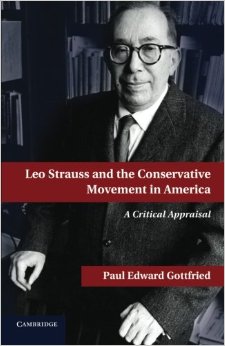
Paul Edward Gottfried, Leo Strauss and the Conservative Movement in America (Cambridge: Cambridge University Press, 2012)
Crusades against paleoconservatives always feature the same charges that those who oppose “sensitive” and “moderate” conservatism are unhinged and seething with hate. And the treatment I suffered may have been on the mild side for those whom the neoconservatives have gone after. Almost any recognizable paleoconservative, living or dead, could tell horror stories similar to mine. Some of the charges that neoconservatives and others associated with the Rupert Murdoch media empire have been making against Donald Trump, a GOP presidential candidate whom neoconservatives don’t want in the race, are really old hat. They are the types of accusations that the neoconservative nomenklatura has been leveling against their opposition on the right for decades. Indeed, it is somewhat telling that there is nothing in the neoconservative grab-bag of rhetoric and sound bites that is not essentially of the Left.
Neoconservative publicists and media personalities in the US, particularly George Will and Bill Kristol, identify their “conservatism” domestically with being loyal establishmentarians. But since the American center, particularly on all social issues, has been veering leftward for decades, this repugnance for the non-establishment Right hardly indicates a conservative orientation. What it suggests is a willingness to go with the leftist flow in return for bipartisan support for a neoconservative foreign policy. Neoconservatives can easily live with a left-of-center government (prominent neoconservatives, including Murdoch, were close to the Hillary Clinton for president camp in 2008) as long as it backs a neoconservative direction in international relations. The neoconservative powerbroker Bill Kristol has already put Republicans on notice that he will back the Democratic candidate for president, if he doesn’t get his movement’s choice for a Republican presidential candidate.

Paul Edward Gottfried, “Multiculturalism and the Politics of Guilt: Towards a Secular Theocracy” (Missouri: University of Missouri Press, 2002)
To their credit, the paleoconservatives defended what remained of a real Right for several decades, and they carried out this thankless task in the face of professional threats. The traditional Right was suspicious of the direction that the civil rights movement was already taking in the 1960s, and they have consistently opposed the feminist and gay crusades with a powerful but generally ignored arsenal of arguments. Paleoconservatives have taken stands against the liberal internationalist foreign policy advocated by the neoconservatives and more broadly, the Republican Party. Critics on the right have resisted this approach because they are deeply skeptical of what Burke mocked as the “armed doctrine” of global revolutionaries. Paleoconservatives also stress the resemblance between the present call for world revolution and the Marxist internationalist vision. The real Right (if I may use this phrase) totally rejects any call by the fake Right for a global democratic revolution. They challenge the view that our transformed America represents such a lofty state of moral enlightenment that we are entitled to cram our progressive values down the throats of the unwilling.
Unlike the neoconservatives and the corporate interests that fund the GOP, all paleoconservatives are immigration restrictionists, oppose birthright citizenship, and underline the difficulty of integrating newcomers from very different cultures. They also maintain that until the US can recover from its devastating commitment to multiculturalism and political correctness, we shouldn’t even try to “Americanize” more immigrants—or indoctrinate with our own aberrations those who are already here. But the differences between the sides go even deeper. Whereas the neoconservatives view most of the rest of the world as being in desperate need of what late modern America has become, paleoconservatives by contrast long for an earlier time, before we became a leftist-neoconservative paradise.
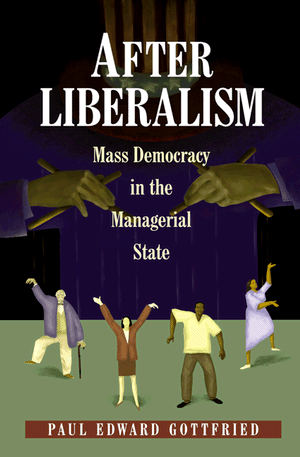
Paul Edward Gottfried, “After Liberalism: Mass Democracy in the Managerial State” (New Baskerville: Princeton University Press, 1999)
Between the two visions of America, there is a clear line of demarcation. One side regards what is best in the American experience as coming to pass in the present age; whereas the other side considers the country derailed politically culturally and socially and looks for ways mostly in the past that were not taken. Typical of neoconservative heroes are Martin Luther King, Harry Truman, the Churchill who fought the (for the neoconservatives) hated Germans in two World Wars, and Abraham Lincoln, as a precursor of the post-World War Two civil rights movement. Paleoconservative heroes include antebellum Southern statesman John C. Calhoun,5 exponent of limited and distributed federal power Senator Robert Taft,6 man of letters Russell Kirk,7 social theorist Robert Nisbet,8 political theorist and critic Richard M. Weaver,9 literary intellectual Mel Bradford,10 and the Southern Agrarian critics of modern industrial society.11 Those who are often cited by contemporary paleoconseravtives include other writers such as Peter Brimelow,12 John Derbyshire,13 James Kalb14 and others.
Although one can occasionally hear a paleoconservative saying something nice about Ronald Reagan or Margaret Thatcher, those political figures are more likely to be praised by neoconservatives, who admire their global democratic tropes and liberal internationalist foreign policy. An inextinguishable enmity between the two sides developed in the first year of the Reagan administration, when a venerated paleoconservative literary scholar M.E. Bradford was passed over for the directorship of the National Endowment for the Humanities.15 The position went to a neoconservative pick, who came out of the moderate Left, William Bennett, after a relentless campaign of character assassination undertaken by neoconservative journalists. Bradford’s negative comments about Abraham Lincoln and his known sympathy for the Confederacy (for which his ancestors had fought) were cited by Irving Kristol, George Will and others closely linked to the neoconservative camp to depict Bradford as a (what else?) “racist”.
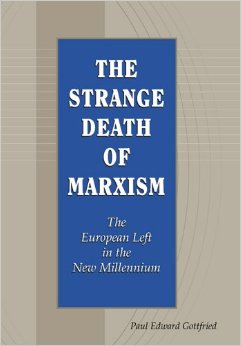
Paul Edward Gottfried, “The Strange Death of Marxism: The European Left in the New Millennium” (Missouri: University of Missouri Press, 2005)
Paleoconservatism has lost cohesiveness as well as resources, but this movement has been displaced rather than totally eradicated. In the 1990s, efforts were made to forge an alliance between paleoconservatives and socially traditionalist libertarians (then known as paleolibertarians). The unifying personality in these efforts was the economist and political theorist Murray Rothbard, who tried to build bridges to traditionalist groups, in the face of growing neoconservative power. After the death of Rothbard in January 1995, this bridge-building foundered because of squabbling between the two camps, and it has never been seriously resumed. Moreover, the paleolibertarians and their talking partners went off in different directions, one toward the almost exclusive discussion of economic questions and the avoidance of foreign entanglement, while their onetime negotiating partners at the Rockford Institute and Chronicles magazine remained in tune with the changing enthusiasms of the institute’s head. Defenses of the Southern secessionists in 1861, Serb and Pan-Slavic nationalism, and militant (often emphatically anti-Protestant) Catholic traditionalism all belong to the peculiar mixture of positions that the reader encounters in Chronicles.
An even more significant direction in which some in the paleoconservative camp have wandered is toward identitarian politics.16 The “Disaligned Right”17 in the US has taken over selectively paleoconservative concerns and absorbed them into their own ideological configuration. Already in 1986, as I pointed out in an essay for Policy Review written at that time,18 sociobiology became a major interest among some of the younger right-wing warriors as they battled against the neoconservative ascendancy. Support for national and cultural particularity against the neoconservative’s glorification of human rights and egalitarian politics had led at least some paleoconservatives into stressing innate differences among different groups based on non-voluntary criteria. Similar arguments were also marshalled against government social engineering, which it was argued was an effort to change human nature through political coercion.19 Since the 1980s, however, this focus among most of the now older paleoconservatives has disappeared. This has occurred largely because of the Left’s escalating war against any discussions of human nature that is not centered on the view that all people are the naturally the same everywhere. Any deviation from this myth, we are told, must result in reactionary repression and the endangerment of minorities; it is therefore just, or so one would believe from listening to our elites, that those who take up forbidden subjects should be punished professionally and socially. Our eyes and eyes must be protected from dangerously divisive ideas.20
But some on the American right have pushed sociobiological issues even harder in the teeth of leftist persecution. Despite the fact that these preoccupations are not my own (I may be too old to change my paleoconservative colors), those of this persuasion have baited the Left and the neoconservatives with fearless determination. They have also been relentless in going after immigration expansionists and exposing the efforts of large corporations to flood this country with an uneducated Third World labor force. Although isolated and vilified by the “conservative” as well as conventional leftist media, those who push “biodiversity,” as they like to call it, from the right cannot be put off by ostracism and intimidation. Indeed by now its rhetoric has filtered through into the columns of Ann Coulter, Pat Buchanan, and other syndicated columnists. For all their exaggerations, indiscretions, and lack of interest in those things that interest me, these mostly young people who focus on innate human differences may represent a genuine movement of the Right. Needless to say, I won’t bet on their coming to power very soon. And I doubt these partisans will get neoconservative funding or media exposure on a Republican channel.
– Paul Gottfried is Raffensperger Professor of Humanities Emeritus at Elizabethtown College (Elizabethtown, Pennsylvania, USA), the author of eleven books, plus numerous essays and book reviews, mostly dealing with political theory, modern European history and American political movements. His works are widely read and discussed in translation in Eastern Europe but receive far less notice in the US, where Professor Gottfried happens to reside. The reasons for this situation are explained above, which typifies the author’s tendency not to hold back when asked to write on contemporary politics.
Endnotes:
- Max Opray, “Rallying the Right” The Saturday Paper (3-9 October 2015) p. 3.
- See for example: Carl Schmitt: Politics and Theory (Santa Barbara: Praeger, 1990), After Liberalism: Mass Democracy in the Managerial State (New Baskerville: Princeton University Press, 1999), Conservatism in America: Making Sense of the American Right (New York: Palgrave Macmillan, 2007), Multiculturalism and the Politics of Guilt: Towards a Secular Theocracy (Missouri: University of Missouri Press, 2002), The Strange Death of Marxism: The European Left in the New Millennium (Missouri: University of Missouri Press, 2005), The Search for Historical Meaning: Hegel and the Postwar American Right (Illinois: Northern Illinois University Press, 2010). Published more recently, see: Fascism: The Career of a Concept (Illinois: Northern Illinois University Press, 2015).
- For example, the French translation of Conservatism in America, translated and republished as Le Conservatisme en Amérique (Paris: L’oeuvre Editions, 2012) was widely reviewed in the French press. The Postface to that volume (which I prepared in French) includes some of the observations that I went into my updated commentary for the ATF. Likewise, a Polish translation of a collection of my old essays, which Arktos Press brought out as War and Democracy (London: Arktos, 2012), and which has been translated and republished as Wojna i Demokracja Michał Krupa (trans.) (Kobierzyce: Wektory, 2014) gained enormous attention in Poland.
- Paul Gottfried, Leo Strauss and the Conservative Movement in America (Cambridge: Cambridge University Press, 2012).
- John Caldwell Calhoun, A Disquisition on Government and a Discourse on the Constitution and Government of the United States Richard Kenner Crallé (ed.) (Columbia: A.S. Johnston, 1851).
- Russell Kirk and James McClellan, The Political Principles of Robert A. Taft (New Brunswick: Transaction, 2010 [1967]). For a comprehensive study of the intellectual Right (from a decidedly uncritical perspective) see also George H. Nash, The Conservative Intellectual Tradition in America Since 1945 (2nd ed., Wilmington: ISI Press, 1996).
- Russell Kirk, The Conservative Mind from Burke to Eliot (Washington: Regnery, 2001 [1953]).
- Robert Nisbet, The Quest for Community (Wilmington: ISI, 2010 [1953]); Conservatism: Dream and Reality (New Brunswick: Transaction Publishers, 2008 [1986]); The Sociological Tradition (new ed., New Brunswick: Transaction, 1993); See also by Paul Gottfried: “Robert Nisbet and the Present Age” Society Volume 52 Issue 4 (August 2015) pp. 335-343 [DOI: 10.1007/s12115-015-9909-z], and the long entry on Nisbet prepared for the International Encyclopedia of the Social Sciences (2015) pp. 832-837.
- Richard M. Weaver, Ideas Have Consequences (Chicago: University of Chicago Press, 1984 [1948]); The Southern Tradition at Bay George Core and M.E. Bradford (eds.) (Washington: Regnery, 1989); Visions of Order: The Cultural Crisis of our Time (new ed., Wilmington: ISI Press, 1995).
- M. E. Bradford, Then Reactionary Imperative (Peru: Sherwood Sugden & Company, 1990); M. E. Bradford, Observations of a Southern Conservative (Athens: University of Georgia Press, 1985).
- Twelve Southerners, I’ll Take My Stand: The South and the Agrarian Tradition (Baton Rouge: University of Louisiana Press, 2006 [1930]); the “Twelve Southerners” are: Donald Davidson, John Gould Fletcher, Henry Blue Klein, Lyle H. Lanier, Andrew Nelson Lytle, Herman Clarence Nixon, Frank Lawrence Owsley, John Crowe Ransom, Allen Tate, John Donald Wade, Robert Penn Warren, Stark Young.
- Peter Brimelow, Alien Nation Common Sense About America’s Immigration Disaster (New York: Harper, 1996).
- John Derbyshire, We Are Doomed: Reclaiming Conservative Pessimism (New York: Crown Forum, 2009).
- James Kalb, The Tyranny of Liberalism: Understanding and Overcoming Administered Freedom, Inquisitorial Tolerance, and Equality by Command (Wilmington: ISI, 2008); Against Inclusiveness – How the Diversity Regime is Flattening America and What to Do About It (Tacoma: Angelico Press, 2013).
- For more details on this controversy, see: Chapter IX of Paul Gottfried, Encounters: My Life with Nixon, Marcuse, and Other Friends and Teachers (Wilmington: ISI Press, 2009) and for a broader political context see: Paul Gottfried and Richard Spencer (eds.) “The Great Purge: The Deformation of the Conservative Movement” Radix No. 2 (2015).
- While identitarianism tends to be a more continental European phenomenon, as per the work of Markus Willinger, it has found some reception in the Anglophone world. See for example: Richard Spencer (ed.) “The Great Erasure: The Reconstruction of White Identity” Radix No. 1 (2012).
- Also known as the Dissident Right. See further: John Derbyshire, From the Dissident Right (vDare Foundation, 2013).
- Paul Gottfried, “Toward a New Fusionism? The Old Right Makes New Alliances” Policy Review 42 (Fall, 1987) pp 64-71.
- Charles Murray, Coming Apart: The State of White America, 1960-2010 (New York: Crown Forum, 2012) and Nicholas Wade, A Troublesome Inheritance: Genes, Race and Human History (New York: Penguin, 2014). By today’s sensitive standards, some of the more “heretical” concepts discussed in these books were once given a platform for debate in quarters that now shun any such discussion: see for example Charles Murray, “The Inequality Taboo” Commentary (September 2005) pp. 13-22.
- For the record: although I have been railed against for, among other things, consorting with the DR, I have absolutely no traction among the Disaligned Right’s followers and am rarely posted on its websites. My only attraction to this group is its obliviousness to leftist bullying and intimidation.
Citation Style:
This article is to be cited according to the following convention:
Paul Gottfried, “Paleoconservatism: A Vanishing Traditional Right” SydneyTrads – Weblog of the Sydney Traditionalist Forum (17 October 2015) <sydneytrads.com/2015/10/17/2015-symposium-paul-edward-gottfried> (accessed [date]).



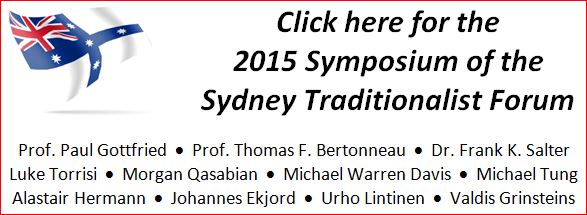
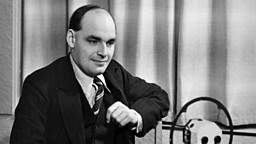
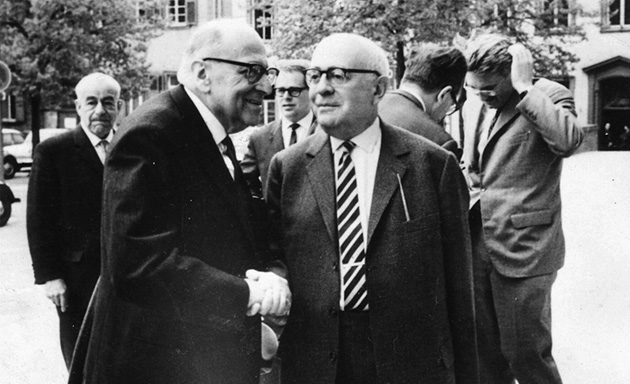


Leave a comment